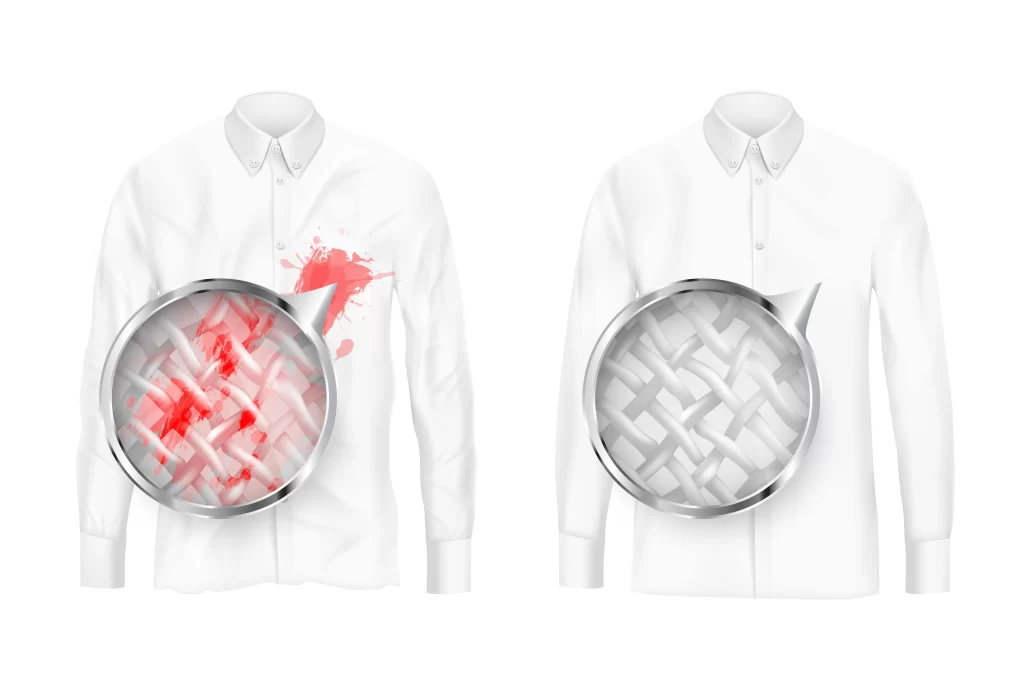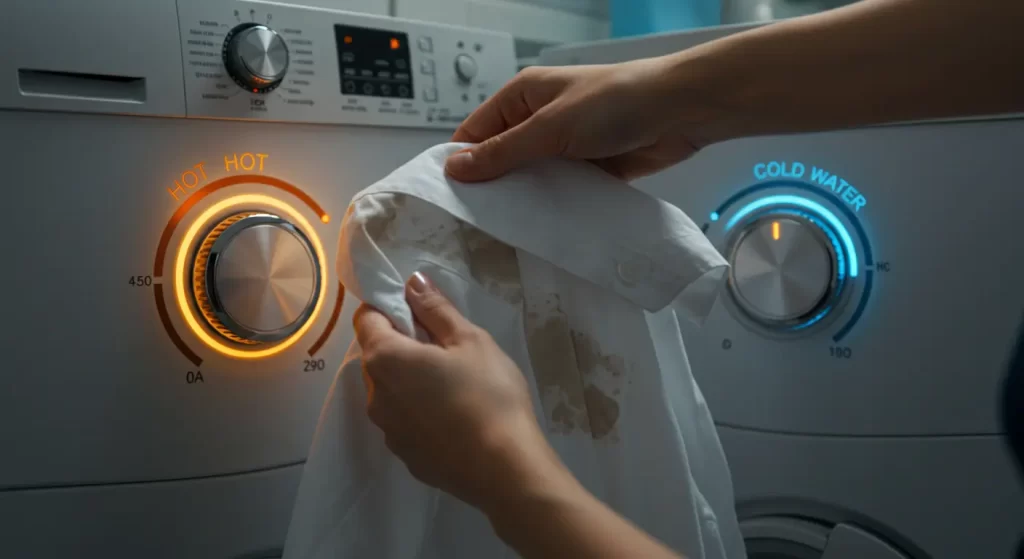
Hot or Cold Water for Stains? How to Choose the Right Temperature
One of the biggest laundry mistakes is not knowing whether to use hot or cold water for stains and selecting the incorrect water temperature, which could actually “set” a stain rather than remove it. If blood is rinsed in hot water, for instance, the proteins may set into the fibres, making it nearly impossible to remove the mark. A garment may be saved or ruined depending on the temperature setting.
At Love2Laundry, we help clients determine whether to treat stains with hot or cold water, making sure that each fabric receives the attention it needs. Many people are also curious about how much water a washing machine uses, and the answer is that efficiency varies depending on the type of washer and the cycle settings. For this reason, hiring professionals makes stain removal easier, simpler, and efficient.
Why Water Temperature Matters for Stain Removal
The temperature of the water has a significant impact on how stains respond to cleaning. Hot water expands fabric fibres, allowing detergent to penetrate deeper and more effectively dissolve oil or grease. Cold water makes it easier to wash out proteins (like blood or perspiration) and dyes (like wine or ink) because it prevents them from setting. For combination stains, such as those found in food or chocolate, which contain both proteins and oils, warm water is often the ideal compromise.
When choosing between hot or cold water for stains, the proper temperature is crucial. If you’re concerned about efficiency, keep in mind that washing on cold settings typically uses less energy, whereas hot cycles don’t necessarily indicate what’s using the most water; they just use more heat, not more water.

When to Use Cold Water for Stains
The safest initial treatment for stains, particularly those containing proteins, dyes, or tannins, is often cold water. Before moving to warmer washes, it gives you more control and stops stains from penetrating the fabric further. Blood, wine, and coffee are examples of stubborn stains that react best to cold treatment.
See our guide on cold wash temperatures for further information.
Blood Stains
Since blood is a protein-based stain, it can become almost permanent if the proteins are denatured by hot water. To prevent the proteins from setting, rinse the fabric right away with cold water. Then, soak it before washing.
Here’s a quick tip: the sooner you treat it, the better the outcome will be.
For more thorough instructions, refer to our comprehensive guide on removing blood stains from sheets.
Red Wine & Grape Juice
Rich in tannins and dyes, red wine and grape juice quickly set deeper into fabric when heated. To remove pigments, rinse right away with cold water before applying detergent, vinegar, or salt. To prevent the stain from spreading further, gently blot rather than rub. The best way to remove stains like wine and juice is to use cold water.
Coffee & Tea
Coffee and tea stains, being tannin-based, can be difficult to remove if not correctly cared for. The pigments may be able to enter the fibres more deeply if hot water is used immediately. Instead, wash with detergent after flushing out as much as you can with cold water. Coffee and tea stains can be prevented from becoming permanent stains by washing them with cold water.
Chocolate
Chocolate contains both oils and proteins from milk solids, making it a challenging combination to remove as a stain. To prevent the protein from becoming embedded in the fabric, begin by rinsing with cold water. A warm detergent wash effectively dissolves greasy residue once the stain has been loosened. Before using warm water, it is much easier to remove stains like chocolate with cold water.
Ink & Dye
Heat tends to cause ink and dye stains to spread and set deeper, making removal more difficult. The colour can be diluted and prevented from setting into the fibres by first treating them with cold water. Using cold water for stains like ink and dye is the most effective way to keep them from becoming permanent.
Mud & Dirt
Clay and organic materials combine to form mud, which easily embeds itself in textile fibres. Using cold water to rinse helps remove dirt particles without causing them to become more deeply embedded in the weave. Wash with detergent as usual after removing the excess.
When to Use Hot or Warm Water for Stains
Some stains simply won’t come out with cold water alone. Hot or warm water is often required to dissolve oil, grease, makeup, and sweat, and to thoroughly clean textiles. Clothes can be left fresh and clean by sanitising and eliminating odour-causing bacteria with hot water.
Oil & Grease
Grease and oils don’t dissolve well in cold water, so even after washing, they may still appear stained on fabrics. To dissolve and remove the greasy residue, use hot water for stains and a powerful detergent. Grease removal is more effective when the correct temperature is used and the right time to use hot or cold water for stains is understood.
Sweat & Deodorant Marks
Although sweat is protein-based on its own, it often leaves behind stubborn yellow stains when combined with deodorant. To stop proteins from setting, start with a cold rinse. Then, wash in warm water with detergent to remove any remaining residue. The most effective method for eliminating sweat and deodorant buildup is to use this temperature balance.
Makeup & Foundation
Since most makeup (foundation, concealer, and powders) is oil-based, it dissolves best in a warm wash. Before washing, pretreat with dish soap or a mild stain remover. Knowing when to apply hot water for stains on clothes helps prevent makeup from further penetrating fabrics.
Lotion & Sunscreen
Oils and waxy substances that stick to fabric are often found in lotions and sunscreens. To remove residue, start with a warm wash using detergent. Before washing, pretreat stubborn areas with a stain remover. These greasy stains won’t last if you know when to use warm or cold water.
Food Oils
Heat is necessary for the breakdown of stains, such as those caused by butter, curry, olive oil, or salad dressing. The most effective method is to use hot water for stains and a detergent. Knowing whether to use hot or cold water for stains helps you prevent leaving unwanted marks and guarantees that the oils are completely removed from the fabric.
When to Start Cold, Then Switch to Warm/Hot
For best results, some stains require a two-step procedure. Proteins, dyes, or sugars are prevented from deeply penetrating fabric by starting with cold water. Using warm or hot water after removing the initial stain helps to break down oils, bacteria, and residues for a more thorough cleaning. When both odour and discolouration are issues, such as with food stains, perspiration, or baby messes, this technique is particularly effective.

Tomato Sauce & Ketchup
Oils and natural dyes (lycopene) are both present in tomato stains. To keep the red pigment from setting, start with cold water. To break down the greasy area, rinse with warm or hot water and then use an enzyme cleaner or detergent. When dealing with difficult tomato stains, it’s critical to know when to use hot or cold water for dye stains
Fruit Juices
Orange, grape, and berry juices are acidic and contain a lot of dye, which can solidify when heated. To lift sugars and colours, start with a cold rinse. To dissolve the remaining sugars, wash warm. Using cold water for stains on clothes is especially effective for preventing fruit colours from becoming permanent.
Baby Food Stains
Protein (milk), sugar, and oils are often combined in baby food. To prevent protein from setting, start with a cold rinse. Then, use a warm wash to remove oils and sticky residue. Baby food spills are much easier to clean up when you know when to use cold or warm water for stains.
Urine, Vomit, or Sweat
These stains are protein-based and contain bacteria that cause odours. To stop protein from sticking to fabric, start with cold water. Then, wash in warm water to eliminate bacteria and completely eliminate odours. Better cleaning results are assured by knowing when to use cold or warm water for stains because temperature selection is crucial.
Stain Type vs. Water Temperature
| Water Temperature | Stain Type |
| Cold water | Blood, Wine, Coffee, Ink, Mud. See more on Cold Wash Temperatures. |
| hot/warm water | Oil, Grease, Sweat, Makeup |
| Cold then hot | Tomato, Juice, Sweat/Urine. |
Learn more about the best temperature for washing white clothes.
Pro Tips to Boost Stain Removal
- Act Quickly: Stains are easier to remove the sooner you treat them.
- Blot, Don’t Rub: To prevent the stain from spreading, gently blot with a clean cloth.
- Check Care Labels: Before applying any treatment, confirm you have followed the care instructions.
- For stains, should you use hot or cold water? For protein stains (like blood or milk), use cold water; for greasy or oily stains, use hot water.
- Test First: Before applying any cleaning solution to the stain, test it on an inconspicuous area first.
- Repeat If Necessary: Some stubborn stains need more than one round of treatment.
How Love2Laundry Can Help with Tough Stains
With Love2Laundry, you can relax knowing that experts will carefully take care of both delicate fabrics and stubborn stains.
- Dry cleaning and laundry are completed on the same day to accommodate your hectic schedule.
- Treatments for specific stains by professional fabric care experts.
- Easy pickup and free delivery at your door.
Put your trust in Love2Laundry to make your clothes feel and look brand new, hassle-free.
FAQs – Hot or Cold Water for Stains
Which stain should never be removed with hot water?
Never use hot water on blood stains, since heat causes proteins to set, making the stain permanent. Instead, start with cold water to help loosen the stain. If necessary, follow with a mild detergent or stain remover for optimal results.
What temperature water is best for stain removal?
Cold water is usually ideal for most stains, especially protein-based ones like blood or sweat, since it helps prevent the stain from setting. Warm water is effective for oily stains, whereas hot water is best for whites and heavily soiled fabrics. Always check the fabric care label before washing.
What is the best stain remover for clothes?
Choosing the best stain remover depends on the stain type, but enzyme-based cleaners are effective for most food, sweat, and protein stains. Oxygen-based formulas are best for stubborn or set-in stains, while gentle detergents or vinegar are suitable for regular spots.
In Summary!
Knowing whether to use hot or cold water for stains can make a significant difference when it comes to laundry. While warm or hot water works better for grease and dirt on long-lasting fabrics, cold water is typically safer for protein-based stains. To prevent damage, always read the fabric care labels. See our guide on getting stains out of white clothes for additional advice on how to remove tough stains.



